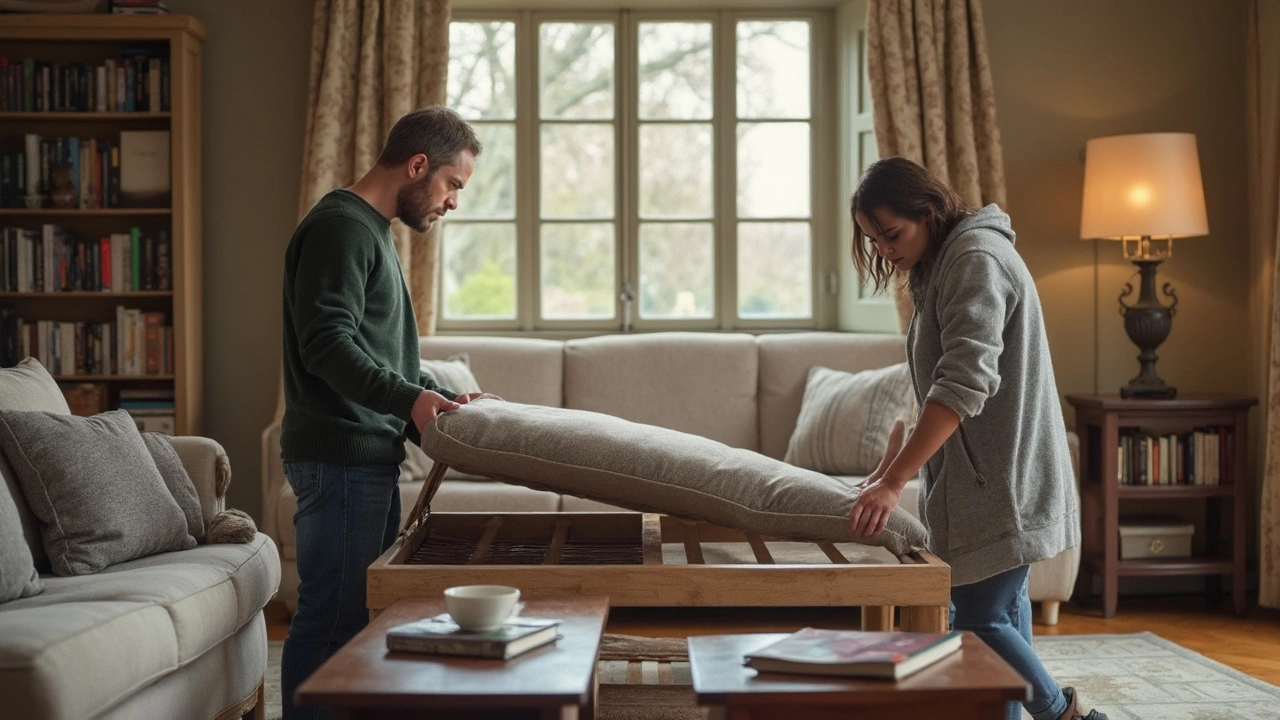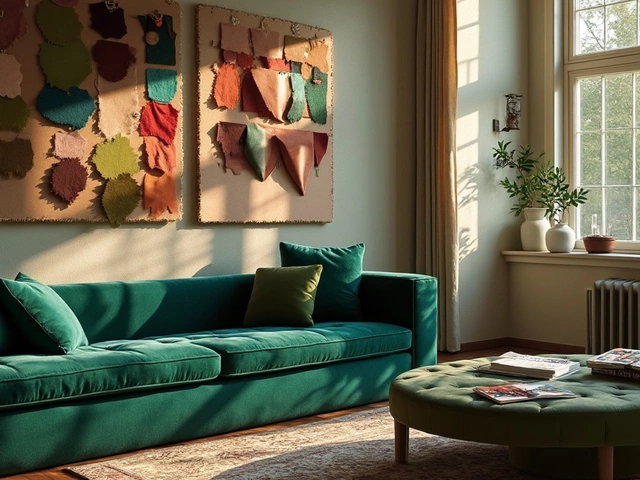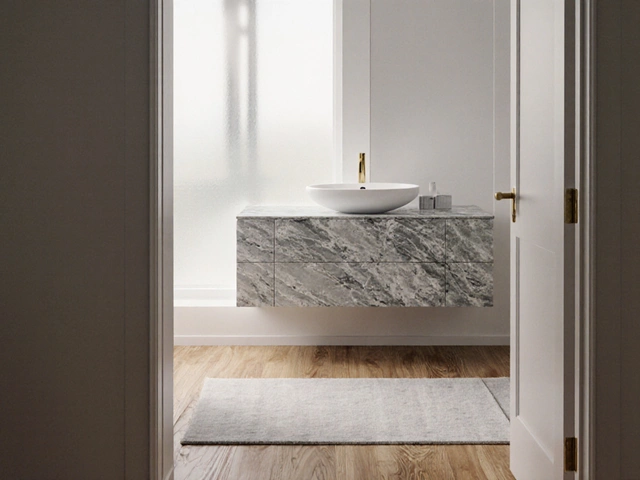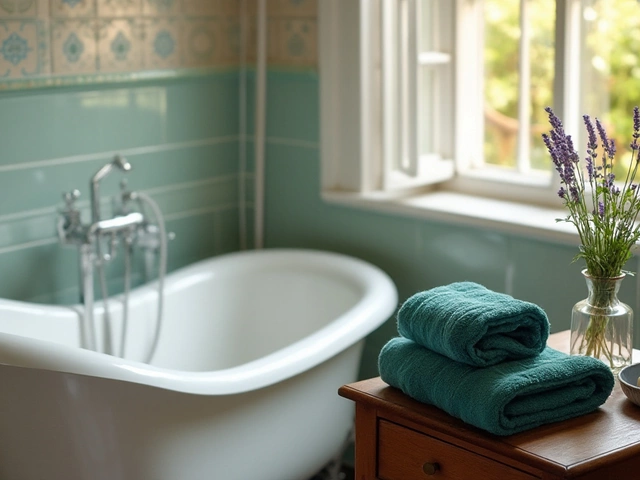Ever sat on a couch that wobbled like a cheap camping chair? Or felt the cushions go flat after just a few weeks? You’re not alone—most people get tricked by flashy showrooms and clever ads. Serious money gets dropped on sofas that look great in perfect lighting but fall apart during real life.
If you want a couch that keeps its shape, survives spilled coffee, and holds up during movie marathons, pay attention to what’s under the surface. Quality isn’t just about how soft it feels in the store. Think about the frame, the fabric, and how everything’s put together.
Don’t just ask a salesperson if something’s "comfortable" or "popular." Dig deeper. Ask what the frame is made of, touch the fabric, and don’t be shy about giving the floor sample a test sit—maybe even a bounce, if no one’s looking.
- What Makes a Durable Sofa?
- Frame and Construction Secrets
- Finding the Right Fabric
- Common Mistakes When Sofa Shopping
What Makes a Durable Sofa?
Let’s cut to the chase—a durable sofa is all about the hidden stuff. You can’t just go by style or color. The best sofa durability comes from a solid frame, strong joints, quality cushions, and fabrics that don’t fall apart after pizza night. Forget all the fancy names; what really counts is what’s under the hood.
Here’s what to look for if you want your sofa to survive years of lounging and family chaos:
- Frames: Hardwood (like kiln-dried oak, maple, or ash) beats softwood or particle board—a hardwood frame can last nearly a decade, while cheap materials often warp or break within a couple of years.
- Joinery: Dowelled, screwed, or glued joints are way tougher than just staples or nails.
- Sofa Cushions: High-resilience foam or a mix of foam and feathers keeps its shape way longer than just basic stuffing. Low-quality foam goes flat fast.
- Suspension System: Eight-way hand-tied springs or sinuous springs give better support and last longer than webbing or cheap drop-in coils.
- Fabric: Synthetic microfiber, leather, and some blends handle kids, spills, and messy snacks better than linen or silk.
Here’s a quick cheat sheet showing what actually lasts versus what falls apart early:
| Feature | Best Option | What to Avoid |
|---|---|---|
| Frame Material | Kiln-dried hardwood | Particle board or softwood |
| Joints | Screwed/dowelled/glued | Staples/nails only |
| Suspension | Eight-way hand-tied | Webbing/cheap coils |
| Cushion Fill | High-resilience foam | Low-density foam |
| Fabric | Microfiber/leather | Linen/silk |
If the store can’t tell you these details, that’s usually a red flag. Don’t just buy by brand or buzzwords—make sure the guts of your sofa are built for actual life, not just for show.
Frame and Construction Secrets
Most people don’t realize the frame makes or breaks a long-lasting couch. If you want a sofa that doesn’t wobble, the first thing to check is what’s under the hood. The best sofas use kiln-dried hardwood like oak, ash, or beech. Kiln-dried wood won’t crack or warp after a few years—way better than softwoods or, worse, plywood and cheap particle board. If a salesperson dodges this question, that’s your cue to walk away.
Joints matter almost as much as the frame itself. Good sofas use wooden dowels, metal screws, or brackets. If you hear “stapled together,” that’s a red flag. For rock-solid sofa durability, you want details like corner blocks glued and screwed into place. Think of it like building a treehouse—it needs solid support in every direction or it’ll collapse at the first sign of trouble.
Spring support is a big deal too. Look for eight-way hand-tied springs if you’re aiming for the very best, or at least sinuous (S-shaped) springs for decent everyday support. Avoid anything that feels saggy in the store—it’ll only get worse at home.
- Frame: Kiln-dried hardwood (oak, ash, or beech is best)
- Joints: Wooden dowels, metal brackets, double-dowelled or screwed corners
- Springs: Eight-way hand-tied equals top tier; sinuous springs are good too
Here’s a cheat sheet you can screenshot or bookmark for next time you’re actually out shopping:
| Part | What to Look For | Avoid |
|---|---|---|
| Frame | Kiln-dried hardwood | Plywood, particle board |
| Joints | Dowels, brackets, screws, glued & screwed blocks | Staples, only glue |
| Springs | Eight-way hand-tied, sinuous springs | No springs, webbing only |
If you stick to these basics, you’ll dodge most regrets down the road. Good construction costs a little more up front, but it keeps you from buying a new sofa every few years. And that’s where the real savings kick in.

Finding the Right Fabric
The fabric you pick is going to decide how your sofa durability holds up over time. Let’s face it: most living rooms double as snack bars, playrooms, or nap zones. So, skip anything that looks good but can’t handle everyday chaos.
Here’s what you need to consider:
- Synthetic versus natural fibers: Polyester, acrylic, and nylon blends last much longer and fight stains better than pure cotton or linen. Leather is tough too, but it needs regular care. If you have pets, avoid anything super textured—claws and rough threads don’t mix.
- Weave and strength: The tighter the weave, the better for long-lasting couches. Loose, open weaves tend to snag and wear out faster.
- Stain resistance: Look for sofas labeled "performance fabric." These options have built-in stain and water resistance, which makes spills and accidents less of a big deal. My favorite brands actually let you wipe ketchup off with a baby wipe. Pretty awesome, right?
If you want real numbers, most upholstery pros recommend a "double rub" rating of at least 15,000 for family use. This fancy-sounding number means the fabric will survive at least 15,000 cycles of back-and-forth action (imagine sitting and standing over and over). Commercial-grade fabric often gets ratings above 30,000.
| Fabric Type | Durability | Best For |
|---|---|---|
| Polyester Blend | High | Kids, pets, daily use |
| Leather | Very High (with care) | Allergy-prone homes, easy cleaning |
| Cotton/Linen | Medium-Low | Formal rooms, adults only |
| Velvet (Synthetic) | Medium | Low-traffic, statement pieces |
If you see wild patterns or super cheap fabrics, ask yourself why. Sometimes those trendy covers are hiding poor quality. Touch the fabric. Try to picture sauce, dog hair, or juice boxes on it. If you’re still feeling confident, then you’ve probably found the right one.
Common Mistakes When Sofa Shopping
Picking a sofa shouldn’t feel like a pop quiz, but it’s easy to mess up and wind up with something you don’t really want. Shoppers trip up all the time—usually because they trust the wrong things or skip the small details. Here’s what goes wrong most often.
- Ignoring the Frame: People focus on the color or cushions and barely ask what the inside is made of. Sofas built with softwoods like pine are cheap, but they’re also quick to warp or squeak. If you want sofa durability, ask for kiln-dried hardwood frames—oak, maple, or ash are safe bets.
- Falling for Fluffy Cushions: Plush seats suck you in at the store, but don’t assume softer is better. Cushions filled with only foam flatten fast. Look for high-density foam wrapped in a layer of feathers or down—and ask about cushion density ratings. (Anything above 1.8 is good for foam.)
- Trusting Looks Over Why It’s Comfortable: A pretty couch can hide cheap manufacturing. If the arms or legs feel loose, or things wiggle when you sit, move on—even if the style is perfect for your room. Brands sometimes staple the fabric to cover up weak joints.
- Not Checking the Warranty: A decent manufacturer will back up their sofa for at least five years on the frame. If the warranty is vague or super short, that’s usually a bad sign for long-lasting couches.
- Choosing the Wrong Fabric for Your Life: Love cream velvet but have a dog, cat, or kids? That’s a recipe for disaster. Durable sofa materials like microfiber, canvas, or leather hold up way better for busy households. And check the cleaning codes—a dry-clean-only sofa will be a headache if you expect spills.
Wondering what most people regret? A 2023 survey by a major furniture retailer found over 40% of customers were unhappy with their purchase within the first year. Most common complaints? Saggy cushions and pilled fabric.
| Top Sofa Complaints (2023) | Percent of Shoppers |
|---|---|
| Sagging Cushions | 41% |
| Pilled/Worn Fabric | 24% |
| Frame Damage | 16% |
| Hard to Clean | 10% |
| Color Fading | 9% |
So, next time you go shopping for sturdy furniture, keep your eyes open. If a deal seems too good to be true, double check everything underneath the surface before you swipe that card.







